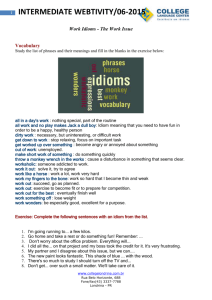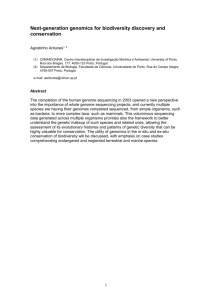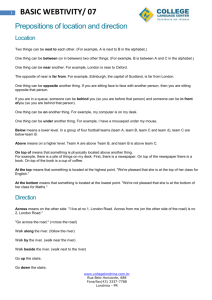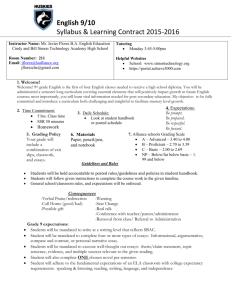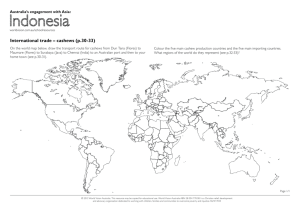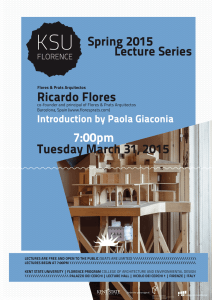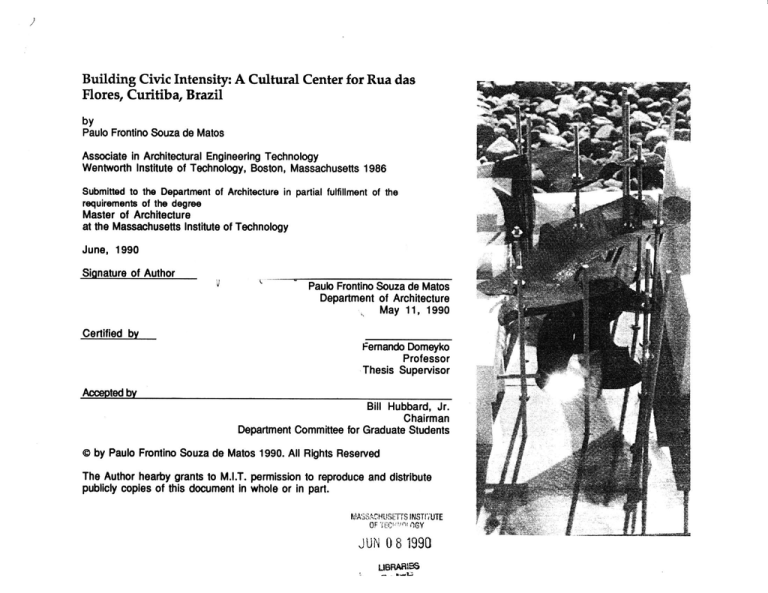
Building Civic Intensity: A Cultural Center for Rua das
Flores, Curitiba, Brazil
by
Paulo Frontino Souza de Matos
Associate in Architectural Engineering Technology
Wentworth Institute of Technology, Boston, Massachusetts 1986
Submitted to the Department of Architecture in partial fulfillment of the
requirements of the degree
Master of Architecture
at the Massachusetts Institute of Technology
June, 1990
Signature of Author
SoAPaulo
________________
Frontino Souza de Matos
Department of Architecture
May 11, 1990
Certified by
Fernando Domeyko
Professor
Thesis Supervisor
Accepted by
Bill Hubbard, Jr.
Chairman
Department Committee for Graduate Students
@by Paulo Frontino Souza de Matos 1990. All Rights Reserved
The Author hearby grants to M.I.T. permission to reproduce and distribute
publicly copies of this document in whole or in part.
MASSA!HUSETTS INSTiUTE
OF TECLP- OGY
JUN 0 8 1990
UBRARIBS
RotOB
For Mary and Vanessa
CONTENTS
TITLE
1
CONTENTS
4
ABSTRACT
7
ACKNOWLEDGEMENTS
8
PREFACE
10
CURITIBA
Transformation of the Downtown Area
Rua das Flores
Description
Experiencing the street: Time line of a Saturday morning in
early June, 1989
13
Weekdays -- a different experience
Analysis of the downtown area
Diagram
New and Old
Movement Systems
29
THE SITE
street
the
of
rest
Two blocks separated from the
Different times of the day, different days of the week: different problems
Contextualism
5
PROGRAM
33
The choice of a cultural facility
Different use scenarios
Technical program
DESIGN
39
BIBLIOGRAPHY
69
APPENDIX A
71
Development of Libraries
6
Building Civic Intensity: A Cultural Center for Rua das Flores,
Curitiba, Brazil
by
Paulo Frontino Souza de Matos
Submitted to the Department of Architecture on 11 May 1990 in partial fulfillment of the
requirements for the degree of Master of Architecture.
Abstract
This thesis focuses on the design of a cultural center and library as a means to
promote civic intensity in the downtown area of Curitiba, southern Brazil. The site
faces a pedestrian zone that acts as a magnet of activity and movement for the whole
downtown area.
The thesis is divided into the following parts: introduction of the downtown area with
special interest on Rua das Flores; explanation and criticism of the site in the context
of Rua das Flores; development of a programmatic concept based on an analysis of the
downtown area; design process based on the belief that architecture is experiential
and buildings ought to be built in harmony and consistency with nature.
Thesis Advisor: Fernando Domeyko
Title: Lecturer
ACKNOWLEDGEMENTS
I would like to thank the family members and friends who made this thesis possible:
Mae, Pai, and Aided Matos and Marcinha de Matos Gonzales for their support on the
home front;
Mom and Dad Downes for their love and support, and for believing in me;
Uncles Cleto and Celso, and Ms Bums, for financially enabling my studies in the
United States;
Virginia Wentworth for her love and emotional support;
Alded Matos for baby-sitting my daughter Vanessa every week during the semester;
John Wentworth for editing and typing (Thanks, John and Lee Grumman for the
11th-hour baby-sittingl);
Bill Boehm for crits, encouragement, darkroom help, proofreading, and many ideas
that made their way into this project;
Tim Smith for crits, proofreading, and encouragement;
Dan Ringeistein for his enthusiasm and drafting help;
Frank Murphy for his modelmaking;
Rob Barnstone for coming down the street from the GSD to help out;
Marc Feeley for his computer expertise and for the use of his Mac;
Chris Falliers and Shira Steinberg for their help drafting;
Simon Eisinger for drafting help;
Mark Three Stars for his modelmaking and darkroom help;
Francesco Passanti for his crits;
Fernando Domeyko, above all, my friend, but also my advisor. I shall never forget
your commitment to the students, your passion for architecture, and your guts to
fight;
And Mary Wentworth, my beloved wife, who deserves the most thanks and admiration
from me, for all her support and hard work and for Vanessinha.
10
PREFACE
This thesis is an attempt to re-establish physical and emotional ties with the city and
life I left behind six years ago, when I came to study in the U.S. The city, Curitiba, is
very close to my heart in a bittersweet way, for some of the best and some of the
hardest periods of my life were spent there.
The choice of a thesis site in my hometown enabled me to connect my present life and
experiences with those of my past. This choice has reinforced my belief that my
education in architecture is universally applicable. I went back and looked at
Curitiba with a critical eye. I tested my memory of the city and discovered new
things about it. I looked for some problem that could become the object of my thesis.
The city has changed very much since I left. While it is still one of the most livable
cities in Brazil, one can see the burden that hyper-inflation produces on people's
faces and postures. However, one can also sense a determination on these same
frowning faces, a determination that speaks of hope for better days.
Many more people live in Curitiba now than when I left in 1984. The growth of the
city is not natural; it is the result of rural exodus. New slums appear overnight to
accommodate newcomers. As the newcomers are unable to find urban jobs,
downtown streets become the place to earn their livelihood and to spend their time.
My desire in this thesis is to go to the cultural and social melting pot of the city and
promote civic intensity, the interaction of people from different age, social and
11
cultural backgrounds. This desire takes me to Rua das Flores, a pedestrian street in
the heart of the city. As an architect, I intend to explore the central importance of
people to my work by creating a place for them to meet and learn in the city center.
This building talks about human relationships with the natural world. Although the
city is an absolutely artificial world; light, rain, the earth and the sky must become
a part of people's lives.
12
City of Curitiba
Downtown map showing
pedestrian street
network, main express
bus terminal, and a few
express bus streets
pedestrian street network
.
main express bus terminal
main pedestrian street
13
CURITIBA
Transformation of the downtown area
In the 1970's, Curitiba's transportation system reached a crisis point. The
population, and consequently the number of vehicles, grew very quickly. The streets
that carried them did not grow to meet demand. Several main roadways joining
opposite ends of the city intersected in the downtown area, creating bottlenecks.
A very appropriate solution to the crisis was implemented. In order to liberate the
center of town from vehicular traffic, some of the main arteries were diverted to
different locations around the downtown area. Public transportation was improved
through the new use of express buses, which connected several points in the
periphery of the city with the downtown area. The new system was appropriate for
Brazil; it was similar to but much less expensive than streetcar transportation.
This new transportation system relieved the local bus routes that service the city,
decreasing conventional bus traffic in the downtown area and reducing arrival points
to a handful, concentrating them in critical locations.
Once liberated from much of their vehicular traffic burden, a few of the most
important downtown streets were transformed into exclusively pedestrian streets.
Approximately two decades after the drastic changes in the center of Curitiba, an
extensive network of pedestrian streets is in place. The main express bus stops and
terminals are connected with pedestrian routes, all of which are located within a 1.2
km diameter circle.
14
Rua das Flores
Description:
Rua das Flores is the nickname for Rua XV de Novembro. It is the geographic
backbone of the pedestrian circulation system in Curitiba and indeed, is the most
important link between areas of downtown Curitiba. The street's pedestrian portion
is a 1 km stretch located between praca Osorio and praca Santos Andrade. it spans the
main portion of the central business district in the east-west direction. The two
squares serve as reference- or end-points to the street, giving it comprehensible
dimensions.
The entire length of Rua das Flores reflects a few chapters in the history of the city
as told through its urban fabric. From the street's beginning, in praca Osorio, large
Art Deco buildings and the wideness of the street reveal what used to be Cinelandia:
places of gathering, movie houses and cafes. Other blocks appear randomly narrow or
wide. A few of the blocks boast 1960's and 70's high-rises. Other blocks are made
up largely of masonry "boxes," two- and three-story buildings from the beginning of
the century. The origin of this building type, to my understanding, was a competition
in the early 1900's to design the most beautiful facade along Rua XV. The face-lifts
many buildings received in that period have come to represent part of the Brazilian
Eclectic architectural style. Nowadays, these "decorated boxes" are protected by the
state's historical society. In one of the blocks of the street, between the streets
Marechal Floriano and Monsenhor Celso, there is a half-block-long piece of arcade
created by the city planner Agache in the 1940's. For reasons that I was not able to
discover, it was never completed. It stands as a displaced piece of urban planning,
never having served the purpose of widening the street for which it was probably
intended.
The white and black stone pavers arranged in local motifs, the urban furniture , the
flower beds that give the street its nickname, the close relationship between
buildings and the street and the people that activate it are constant characteristics of
Rua das Flores.
Typical Brazilian
Eclectic buildings:
"boxes" with elaborate
facades
Q-i. JA~ \
7
reAr
N gI-w94
N
*
15
RUA XV DE NOVEMBRO
Above: Rua das Flores
from praca Osorio to
praca Santos Andrade
Right: praca Osorio
Far Right: praca Santos
Andrade
-
A PROMENADE THROUGH THE CITY
16
Above Left: Beginning of
Rua das Flores (formerly
Cinelandia)
Below Left: High and low
buildings co-exist along
multi-width street
17
Above Left: Intersection
of Rua das Flores and a
vehicular street, Rua
Doutor Muricy
Above Right:
Intersection of Rua das
Flores and Rua Marechal
Floriano
Below Right: Informal
gatherings are a common
occurrence along Rua
das Flores. (near
intersection of Rua
Marechal Floriano)
18
2.5 MIN.
3.5 MIN.
4.5 AIN.
5 MIN. 5 MIN. 4.5 MIN.
2.5 MIN.
Above: Times required to
walk non-stop to various
points along Rua das
Flores from its
endpoints. People
typically traverse these
distances much more
slowly.
Below: Saturday morning:
music, art, and politics
19
Experiencing the street:
Time line of a Saturday morning
.---
"*N
in early June, 1989
9:30 a.m. I arrive at a large city-owned parking lot near a major express bus
terminal. Driving a car, I realize immediately, is a bad start for my visit, for it
disconnects me from most people around me. Most people who have come down to
work or to walk around downtown have taken public transportation. Most of them
have no alternative; I do, but I have been influenced by the same mentality that
makes Americans drive a block to get the Sunday paper. My intention in coming to the
general location of my site on a Saturday morning is to experience the street from
the perspective of a native, but it soon becomes apparent that I am a spectator,
somewhat detached from the reality of this place, my former hometown. For the
most part, my memories of the place will have to be confronted from the perspective
of a critical observer. I walk on a pedestrian street next to people who are clearly
not in a hurry, absorbing the winter sun. As I walk, I worry that Rua XV might turn
out to be a disappointment, different from my recollections of a few years ago.
Above: A site-sketch
10:00 a.m. As I arrive at the place where praca Osorio becomes Rua XV, I realize
that Rua XV is still, by definition, the place of the people. A rally to promote the
be
protection of the environment is taking place. Activists speak, children sing and a
band of veterans plays music. Some people browse, some observe, and some
participate. I hear somebody say that in this year of presidential elections,
demonstrations of this sort have become common. My experience is positive from the
start, I identify with the demonstrators' fervor to protect the environment.
Presidential elections are an absolute novelty for me since I never had the
opportunity to vote for President, but I feel the energy of the political moment.
om visit
Below: Drawing made
from a slide of the site
In the same area, local artists exhibit and sell their paintings - abstract landscapes
and still lifes with local themes.
I meet a friend, and for a moment participate in the festivities of the morning. We
reminisce as we walk together for one block and sit down for a beer in a bar in the
middle of the street.
1/X
/
20
11:00 a.m. Suddenly I realize that I have been sitting and drinking beer in a building
that is without walls, yet is separate from the surrounding spaces. Part of my
experience of this street is the periodic awareness of the reciprocity between
buildings and the street that they face. In this case, the building has claimed a chunk
of the street as part of its territory and the street, in return, passes through the
building.
12:00 p.m. Finally, after a few blocks and about two hours, I reach the location of
my site, at the intersection of Rua XV and Rua Marechal Deodoro. The site is located
approximately in the middle of the pedestrian portion of Rua das Flores. Depending
on a person's frame of mind, the distance between my site and praca Osorio can be
covered in 5 minutes, but that is quite difficult to accomplish.
At the site and at the block before it, Rua das Flores is interrupted by vehicular
streets. The off-white paving is broken, the flow of people stops, life comes to a halt
as the stop lights are open for cars and buses to pass, a reminder of the reality of
modern life in the city. The two interruptions on Rua XV are major public
transportation streets that bring to and take away large quantities of people from the
center of the city.
The block of Rua XV delimited by the two vehicular streets is severed from the rest
of the street. It is isolated, ambiguous because it is meant to be as dynamic as the rest
of Rua XV, static, similar to a square. However, Saturday's light cross-traffic does
not disturb pedestrians.
12:30 p.m. Noticeably fewer people remain In the street. In another half hour, when
shops close down, street life will die just as it does every Saturday afternoon. It is
strange to look at Rua XV after people have left, it becomes like an empty stadium
after a big game - echoes of the happiness and the noise seem to float in the air. Thus
ends my first visit to Rua XV, interrupted by the law that forces businesses to close
down at 1:00 p.m. on Saturdays- one of the many laws locals consider senseless.
Above: A bar in the
middle of Rua das Flores.
Fuzzy distinctions
between public and bar
territories.
Below: Cafe in the middle
of Rua das Flores - the
entrance is also used as
a street.
I
21
Week days: A different experience
On week days, much of Saturday's gay atmosphere exists, but the rallies are replaced
by small groups of men "hanging out" at the Boca Maldita, "Infamous Mouth,"
discussing politics, soccer, the economy and other subjects deserving their attention.
The "Infamous Mouth" Is an informal men's club dedicated to discussion and gossip
that makes Rua XV its home.
Unlike Saturday morning, weekday rush hours exist, although a term such as nonstopping hour would be more appropriate, as people rarely rush to work. As a rule
two main groups of people can be seen among those occupying the street: those who
are trying to get some place and those for whom getting some place, at least in the
immediate future, does not matter all that much.
I reach my site fairly quickly, as I am one of those trying to get some place that
morning. On the way, I participate In the choreographed motion of pedestrians
crossing the streets that intersect Rua das Flores. Today, the experience of waiting
while catalytic-converter-less cars and buses go by Is a little different from the
previous Saturday morning. Most people around me do not mind waiting, but some
fairly suicidal or impatient people take on the cars and cross the street. Rua XV is
still a paradise for pedestrians.
22
The site is a long, narrow sliver of almost vacant land, serving as a parking lot and a
billboard site. A small, fabric store sits in one of the corners. The lot is very
desirable, but because the family who owns it is not able to agree on what to do with
it, the property remains undeveloped.
Next to the site, along Rua das Flores, stands an old three-story building that sticks
out about 2 meters into the street.
Continuing on Rua das Flores, but still on the block of the site, there exists an arcade
on both sides of the street. Apparently, it was built to widen the street for the entire
length of the block, but was never completed. The presence of the arcade has a very
negative effect on the street. It creates a layer between the street and the entrances to
buildings that is dark and unused, redefining the formula of reciprocity that makes
the street work so well.
Once the arcade ends, the street regains the vitality it has on the stretch between
praca Osorio and the first vehicular street that interrupts Rua XV. Small businesses
face the street, re-establishing a close relationship with it. This block is built-up
with two- or three-story Brazilian Eclectic buildings. A few restaurants and a
famous pastry shop are the main meeting places in the area. The reciprocity between
open and interior spaces is perhaps best demonstrated where the street finds its way
past the facade of one particular building. Here, paving continues inside a combined
movie theater, coffee shop and restaurant. The relationship between the street inside
the building and the activities within breaks down barriers between Rua XV and the
buildings that face it. The building is an extension of the street.
The last block of Rua XV before praca Santos Andrade Is also cut by two vehicular
streets. Despite the interruption of vehicular traffic, the block is long and
pedestrians do not quite lose their momentum. The street is darkened by tall
buildings on both sides.
In the afternoon, the whole extension of Rua XV becomes busier. But the festive mood
is replaced by the discomfort of a crowded street. The population growth that
The intersection of Rua
das Flores and Rua
Marechal Floriano. The
building next to the
empty lot protrudes 2
meters into the street.
PME
23
originated downtown pedestrian arcades is beginning to overwhelm streets and
squares.
At 4:00 p.m., all banks close down for business and as a result, some portions of the
street become Instantly lifeless. Eventually all businesses close down and
lifelessness spreads throughout Rua XV. Nothing happens on the street at night to
give it life. It becomes a desert.
Above: Schaeffer gallery:
street-like qualities
inside the building
Below: Painting
workshop for children on
Rua das Flores
FM
- -
24
INVENTORY OF PUBUC MOVEMENTAND BUILDINGS
Pedestrian Netwok
Major VehcularNetwork
Open Air Mak*ts
Cuftural kLstkutLow
Educational Institutions
Banks and Department Store
Site of Project
25
Analysis of the Downtown Area
Diagram
The diagram of downtown Curitiba shows the major pedestrian network created in the
1970's as well as the major vehicular street network. Rua das Flores is located in
the middle of this network.
Although a fairly large number of educational and cultural institutions exist in the
general area, the street is over-populated with banks to the point that current
zoning regulations prohibit the building of new banks-there. The fact that banks are
only open for business four hours a day creates problems for Rua das Flores. During
most of the week and the entire weekend, a large number of buildings along Rua das
Flores are closed. Large department stores have begun to locate along the street.
This, in my opinion, creates a problem for Rua das Flores because these stores
develop a parasitic relationship with the street, not contributing to its life and
activity.
26
Open-air market in
Largo da Ordem irea
27
Now and Old
SNext
page:
Above: Paul Klee's
"Illuminated Leaf"
(watercolor), 1929
Below: Downtown
Curitiba
Largo da Ordem, where
Curitiba started
The diagram of downtown Curitiba shows two main directions that determine the grid
of streets. The majority of the downtown follows an orthogonal grid and is diagonal to
the traces of the old part of town that grew on the ridge of a hill. The old town is a
point of interest to the city because of its historical value, but has acquired more
significance recently, because it has become an important cultural area. Museums
and other cultural buildings as well as an open-air market that functions on
weekends attract thousands of people during different times of the week. The link
between the center of town and the old town is of great importance to the city. The
vehicular street that crosses Rua das Flores, one edge of the site for this project, is
one of the main connections between the downtown and the old town area. Therefore
the site is in a location that Is important to the connection of two of the most
important portions of downtown Curitiba, the Rua das Flores area, representing the
new town, and the Largo da Ordem area, the place where Curitiba started.
28
Movement systems
The Klee watercolor...adds...[a] dimension to the structural movement of
energy within the city: the creation of fields of quality at the points of
convergence of movement systems. Since the veins of a leaf or the
branches of a tree are comparable to the channels of movement of people
and goods within a city, we see the parallel between organic structural
forms and the city movement system, their sequential effect on the
sensibilities of the people who move over them, and the resulting effect on
the appearance and character of the city adjacent to them.
In this painting we see that it is the movement systems which determine
the shape of the fields of influence. These vary in intensity with the degree
of movement, overlapping one another as they radiate outward."
-Brawne, Libraries: Architecture and Equipment
The downtown area is a network of activities and movement. Squares, bus terminals,
cafes, newsstands, and street intersections are points of intense activity. As the
diagram of the downtown implies, the city is concentrically arranged with radial
connectors between the residential neighborhoods and the center of town. The notion
of nodes of activity within movement systems from Klee's painting can be applied to
the downtown diagram. As a result, the intersection of Rua das Flores and Rua
Marechal Floriano is one such node of intense activity. The opportunity exists to
expand the Influence of this node of activity so that it overlaps with the adjacent
nodes, creating a large network of activity in the downtown area.
29
THE SITE
Rua das Flores is an important component of the experience of Curitiba for many
thousands of people. It Is a station within time and space In the city, whether it is
used as a connection between the express bus terminal and the work place, or as a
destination in itself.
Two blocks separated from the rest of the street:
The block between Rua Doutor Muricy and Rua Marechal Floriano, in the middle
section of Rua das Flores, is separated from the rest of the street by motor traffic at
either end. This isolated area has characteristics of a square, a multi-directional
field of movement, a place of arrival in the center of town. Although the block is
busy, it is not lively. I believe this is because the street is bound by elements that do
not contribute to the quality of life on it. Two vehicular streets interrupt the
continuity of the pedestrian street and both edges are built up with high-rises of
twenty or more stories. It also has a major department store. People using this
block do not inhabit the street, but rather use it as a way to get into the internal
world of office buildings, as a bridge between two portions of a pedestrian street, or
as an gateway to the downtown area. I believe that this block can become a legitimate
plaza, a special point in the middle of the street, a destination in its own right, by
re-establishing its importance as a site of activity. A school on the perimeter
activates the block, but more has to be done to bring it to life.
Above: Rua das Flores
and two vehicular streets
that cross it (shaded)
Below: Interrupted
arcade
30
The arcade running half of the block between Rua Marechal Floriano and Rua
Monsenhor Celso separates the street from the buildings it faces. It works as a
barrier to light, and therefore to vision and activity. This zone between buildings
and street is not used by people as a part of the street, nor is it claimed by buildings
as extension to their territory. Therefore one of the main characteristics of Rua das
Flores, the reciprocity between building and public space, doesn't exist along this
block. If the arcade were to be connected to Rua Marechal Floriano, it would acquire
the continuity that would make it function as an integral unit of the street, and, I
believe, the block would share the lively character of most other blocks of the street.
Different times of the day, different days of the week:
different problems
The street functions very differently at different times of the day and on different
days of the week, in part due to the position of the sun. Morning light illuminates the
length of the street making Rua das Flores an important pathway to travel to work.
In the afternoon, the sun illuminates one side of the street, which becomes the most
active side. On the well-lighted side, Rua das Flores becomes more than a street,
with outdoor cafes, flower shops, and spontaneous activities. The shaded side of the
street becomes the movement side, a traffic corridor. At night, the lighting is poor
and life almost stops.
Life on the Rua das Flores is related to the activity within buildings along it.
Therefore, commerce, banks, and office buildings, for the most part, determine the
times in which the street is allowed to fully function.
According to Fernando Popp of Curitiba's urban planning institute, the institute
recognizes this problem and is studying ways of creating 24-hour activities along
Rua das Flores, in order to make it both safer and as Important to the city at night as
it is by day. Similar strategies would activate the street during weekends.
31
Contextualism
My approach to the context of my site is to identify the relationships between street
and buildings that generate activity and life in the city and to incorporate them in the
concept of my design. The building to be built on the site ought to enhance the quality
of life and activity the area already has.
J
Sri
-
44..
-
J
-.
).!rXh( I
tPr~T -P
'~
-
'I
~
5,47 b4
00"Wr%
hJo-
o
e4''-J~-D9
''-k-tf
-UP
4-t,w.
t-ljqo &-
1
pe
Diagram. Dynamics of
building and street
relationships
32
Rua das Flores is the most important border of my site and the most important
determinant of my attitude toward context. The exchange of activity between building
and street is achieved by buildings of external character as opposed to buildings such
as department stores and office buildings. The buildings that work the best to
establish the relationships that interest me are the two- or three-story buildings
located along Rua das Flores. My proposal will have the following relationships with
and effects on the edge of Rua das Flores:
-Establish continuity of the street by allowing the connection of the
arcade to the vehicular street;
-Help activate the block between Rua Marechal Floriano and Rua
Doutor Muricy;
-Be an extension to the street;
-Be one more place in the sequence of places for public use that exist
along the street;
-Be the entrance to a more defined destination or activity;
-Offer a range of choices of use, be multi-purpose
-Activate the street at night.
The long dimension of the site facing Rua Marechal Floriano is lined with very high
and internally-oriented buildings. The whole length of the block has bus stops that
can be occupied by as many as three buses at one time. In relation to this street, the
new building will be:
-Agateway downtown;
-The urban edge along the street;
-Movement as it faces this street.
Along the third edge, Rua Marechal Deodoro, the new building will follow the existing
character of the street. It is a street of big buildings, cars, trucks, buses, banks and
33
chaos. This side of the building will be institutional, perhaps as imposing as its
neighbors. This side can serve as a service to the building as it functions now as a
service to Rua das Flores. The building will not be very accessible to this street.
34
Opposite Page:
Above: Periodicals
reading table similar to
type used by Aalto in
Viipuri library
Below: A "cloud" of
books as proposed by
Bruno Munari. Exhibited
in Milan
35
PROGRAM
The choice of a cultural facility
My reflections about what I saw and heard in Curitiba and at Rua das Flores made me
realize that a cultural center was the best building for the site, as it would encourage
interaction between people from different walks of life. The cultural center should
derive its life from the phenomenally complex part of the city surrounding the site.
I decided that the building should offer a range of uses, validating the claim that the
building is an extension of Rua das Flores. In order to arrive at the technical
program for the building, I conceived three scenarios that exemplify the range of
uses that I see for the center.
Different use scenarios
-Browsing. People may walk in from the street and read the daily newspaper glued
to the wall or displayed on "browser" tables. A person may also walk through a
"cloud" of books or view an exhibit of local crafts, or buy a cup of coffee and continue
along Rua das Flores. Ufe goes on after a quick break. The place where the break
takes place does not seem very different from the street itself.
-Study. The building isalibrary and meets the need young people have for places to
study as they prepare for university entrance exams. For most students, serious
study is the only hope for a promising future.
36
The location of this place to study is very strange, for the student needs to be able to
concentrate in order to be productive and this site is so very busyl However, the site
is perfect for studying, for it is located near the schools and homes of the people who
need it. The library is a refuge, a second home to the student. Here the student can
take a nap on top of his notes on the busiest corner of town. It is a rock, a solid
depository of knowledge.
-Public gatherings. A musician may play guitar to earn some money in the lobby of
the building. A band may play an informal concert during a lunch-time concert
series. Bank clerks, secretaries, students, cops, children, and street people sit
around watching the performance. Public activities of different kinds happen during
the day: art exhibits, lectures, music, dance performances.
This part of the
building is a chameleon-- it has to constantly adapt itself in order to work.
Once I established the function of the building in the context of Rua das Flores, the
development of the program was aided by observations of the site as well as two
books: The Influence of Angus Snead Macdonald and the Snead Bookstack on Library
Architecture by Charles H. Baumann and Allan Konya's Libraries: A Briefing and
Design Guide.
Snead Macdonald invented structural bookstacks and other equipment found in
libraries today. His inventions reflect a deep understanding of many issues that have
to do with the functioning of a library, such as book storage and retrieval, and the
quality of the spaces for reading. Konya's book, on the other hand, presents case
studies in library design.
Macdonald maintained that traditional libraries "... don't assume a more vital role in
our society because they are in architectural straight jackets." (p.123) The three
fundamental faults of traditional libraries were their lack of intimate charm,
inadequate accommodation and narrow class interest. Libraries ought to be usable.
His structural bookstacks are greatl Other equipment invented by Macdonald reflect
his belief that access to the books is of capital importance to the serious reader.
Structural bookstacks in
the Library of Congress
37
Structural bookstacks allow freedom in the design of the building by relieving the
loads caused by books. The books are stored in rational and compact locations, easily
accessible to the reader. Macdonald also proposed the use of "interchangeable stack
spaces" (p.125) to allow for flexibility in library configurations and studied
modular library configurations. These aspects of his work are not as relevant to my
thesis as his bookstack designs.
Konya discussed the issue of library design in terms of functions that correspond to
the cycle of use: locating Information, retrieving information from storage,
communication of the information to the user, and return of information to storage.
Based on his writings, I decided that the attraction element of the library, the part
that includes lending and reference, should be at or close to street level, whereas the
research component should be relatively secluded with respect to the rest of the
building. I developed a program for the building following Konya's guidance, adapting
his design procedures for a library that is a part of a larger cultural building.
'IT~V
VOEIEE
Above: Typical
structural
stacks
bracket
Below: Longitudinal
section of Library of
Congress structural
bookstacks
38
TECHNICAL PROGRAM
Though Curitiba has approximately 1,000,000 inhabitants, the program is designed
to service 100,000 people. The reason for a design population of 10% of the actual
population of the city is that there is already a public library, albeit too small, in
the center of town.
750
750
200
400
m2
m2
m2
m2
Adult Lending..............................................................................
Reference Area............................................................................
Children's Library.....................................................................
Mediath6que (media library)....................................................
Materials, storage and remaining book stock of
200,000 volumes......................................................................
Seating room for 100 students...................................................
Meeting/seminar room for 200 people.....................................
Lecture hall and theater for 300 people....................................
Catalogue and counters................................................................
Photocopy room..........................................................................
Offices and workrooms...............................................................
Staff area....................................................................................
Entrance hall and circulation.....................................................
Mechanical, electrical, services................................................
Bookshop.....................................................................................
Cafe.............................................................................................
Exhibition Area..........................................................................
1600 m2
140 m2
420 m2
400 m2
70 m2
20 m2
300 m2
90 m2
300 m2
150 m2
80 m2
80 m2
200 m2
Total Area............................................................
5950 m2
39
DESIGN
This chapter provides a graphic
description of my design exploration.
The organization of this chapter is as
follows. The concept for the building is
established through models that
progress toward clearer definition.
Programmatic elements are
incorporated that change the concept into
a building. Only after several iterations
of model-making does sketching become
part of the process of design. Eventually
drawings become the main exploration
tool of spaces. Finally, the explorations
are tested in a model.
I
40
The plaster, wood and metal model is the
beginning of the design exploration. The
main concern is to develop a concept
with respect to the site and to the
natural elements.
The two walls are an attempt to
establish a simple initial definition of
space and separation from vehicular
traffic of Rua Marechal Floriano. The
thick dimension of the plaster wall
allows for movement through and along
it.
The ground plane is denied by the
intensification of what is underground.
The base of the model is threedimensional and so is the space that
makes the connection between ground
and sky.
The sky is revealed through structure
and transparency. Light can penetrate
different layers of material and reach
below the ground plane.
Making the model is an exploration in
materials, assemblage and tectonics.
41
The second model synthesizes attitudes
towards the natural elements: ground,
water, and sky. The ground moves above
and below a reference ground plane to
create places and enclosure. The sky is
harnessed to become part of the building
through light-catching devices. Rain,
the water flowing from the sky to the
ground, defines the flow of forces along
its path.
F=_E
42
The concept of space and enclosure is
first introduced to the site. The existing
three-story building on Rua das Flores
is engaged by the new building due to
dimensional constraints of the site. This
edge of the site is very threedimensional and little defined. The
building is an extension of the
pedestrian street.
The end of the site opposite Rua das
Flores is a well defined container; it is
the institution, the library.
WIF-
Z_
43
The Rua das Flores dimension is very
important to the building. The threestory building adjacent to the site has to
be removed in order to allow the new
building to create civic intensity.
The model is an exploration of
movement, light and creation of spaces
that range from loosely to well defined.
The spaces are defined by vertical and
horizontal planes that are held up by the
beginnings of a structural system.
44
Places, movement and construction
become more clearly defined. The
building is separated by a "wall" of
structural bookstacks which cut the
library from the more public part of the
building.
45
To eVxIV-To
Lt
Arow~
46
7
47
The building has a theater for plays,
lectures and movies. The stairs that lead
to the theater themselves become a
theater during the day. Cultural
activities are both formal and informal.
48
The library is defined as a zone for
movement, a zone for book storage, and
the space between, which becomes the
main reading room.
N
49
,nou
p.fr
A vUt-IS
Ci-5)AEI
tls
"Ac8-
50
51
THEATER LEVEL PLAN
w
1m
5
52
53
54
NYid'13A31.L3HIS
. . .
. . . . . . . .
9r
..
...
.
.
.
.
.
.
.
.
...
...
.
I..........
~N.SSM8
3WNiX=
56
57
FIRST FLOOR PLAN
1m
5
58
THIRD FLOOR PLAN
5
1m
2
5
59
CHILDREN'S LIBRARY PLAN .
1m
2
5
60
61
62
63
O
-
CI
I
I!--
15--
11
1I
1
7'1-_ Aiv~
_____
t~
-~
.
-
~
lk
,
i
_____
,I
:
-
-
-
-
oOO,)
60o
)j-o
%.o%J
__
...........
1t
77
Coo
__
~_____ti
1 .
.~
'if
V
64
65
66
67
68
69
BIBLIOGRAPHY
Bacon, Edmund N, Design of Cities. New York: The Viking Press, Inc., 1967
Baumann, Charles H, The influence of Angus Snead Macdonald and the Snead Bookstack
on Library Architecture. Metuchen, NJ: The Scarecrow Press, Inc., 1972
Brawne, Michael, Libraries: Architecture and Equipment. New York: Praeger
Publishers, Inc., 1970
Fusaro, Florindo, ed., Le Biblioteche di Alvar Aalto. Rome: Editioni Kappa, 1981
Green, Kevin W., ed., The City as a Stage: Strategies for the Arts in Urban Economics.
Washington DC: Partners for Livable Places, 1983
Kadzia, Christian, Behnisch & Partners. Architects: Designs 1952 - 1987.
Stuttgart: Edition Cantz, 1987
Konya, Allan, Libraries: A Briefing and Design Guide. London: Architectural Press,
Inc., 1986
Nakamura, Toshio, ed., Renzo Piano: Building Workshop: 1964 - 1988.
Tokyo: a + u Publishing Co., Ltd, 1989
70
Packard, Robert T., ed., Architectural Graphic Standards. New York: John Wiley &
Sons, Inc., 1981
Poma, Maria Cristina, ed., PomaGiancarlo De Carlo: Architetture. Milano:
Arnolodo Mondadori Editore SpA
Shortridge, Steven S, Form Elements of Houses: Investigating the Collective Form of
Detached Houses. Cambridge: MIT. M. Arch. Thesis, 1989
Tunnard, Christopher and Pushkarev, Boris, Man-made America: Chaos or Control?
New Haven: Yale University Press, 1966
Appendix A - On
Library Tradition
excerpted from Brawne's
Libraries: Architecture and
Equipment
A painting by Antonello da Messina of St
Jerome in his fourth-century AD
library shown on this page introduces
issues of design that must still be
addressed today. Although containing
only 30 or so volumes -representing
much of what was then known- St
Jerome's study makes use of a simple
scheme for organizing information and
suggests how a reader's mind is best able
to focus upon it.
Saint Jerome in his
study by Antonello da
Messina
The study is a wooden platform with
furniture within the larger space of a
house. It is raised above a cold tile floor,
well-lit and comfortable. It is a private
place of study, but at the same time, it is
connected with the world beyond the
house. Furniture, enclosure, space,
light, outlook are all manipulated to aid
the communication between the book and
the reader. Therefore, the painting is a
discourse on the essence of a library: the
72
availability of knowledge and the
conditions needed to attain it. Of course,
as the Antonello's painting reflects
monastic period conditions, its value Is
only conceptual.
Historical Sequence: two
traditions
Two distinct traditions occur in the 8century span between the library of
Ptolemy lI, circa 111 BC, and
Michelangelo's Biblioteca Laurenziana in
1524:
Single room, few books. Roman colonial
prototype with an emphasis on books and
a room in which to house them. Book and
space become one Architecture. Readers
use open space in middle, as in the
library at Ephesus.
Monastic. Prolonged periods of study in a
harsh environment typified by carrels.
Main characteristic of reading spaces is
a delimited enclosure within the general
space, as is the case at Gloucester
Cathedral's cloister. This relationship
eventually became an architecture
intentionally designed - an accumulation
of such carrel spaces is found, for
example, in Cambridge University:
enclosure determined by furniture -
Top Left: Gloucester
Cathedral cloister. Late
XIV or early XV century
Above: Michelangelo,
Biblioteca Laurenziana.
Florence, 1529
Left: Freising,
Oberbayern, 1732-1738
73
each user has direct access to whole
collection. This architecture worked as
long as the number of readers was small.
The invention of the press and the
ensuing proliferation of books brought a
return to the Roman library prototype,
with books lining the walls, as in
Freising library, in Oberbayern.
Above Left: Boulle.
1785-1788. Shrine of
Knowledge.
Above: Bibliotheque
Saint Genevieve, Paris,
1843-1851. By Henri
Labrouste
Left: Bibliotheque
Nationale, Paris. Multistory top-lit stack with
floor grating to carry
light down. Library
With a rising number of readers and
volumes, the library was separated
from larger institutions, such as the
university. The first public library was
designed in 1774-78. Thus libraries
acquired the role of education in general.
Boul6e's symbolic representation of a
library in the shrine of knowledge
project had immediate appeal.
The principle of separation of libraries
into stack space, reading room and
offices was a direct result of the
increase of number of books available.
An example of the tripartite scheme is
Biblioteque Saint Genevieve in Paris.

